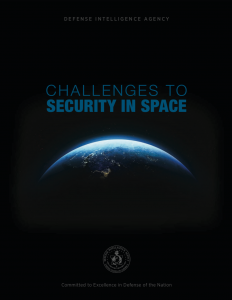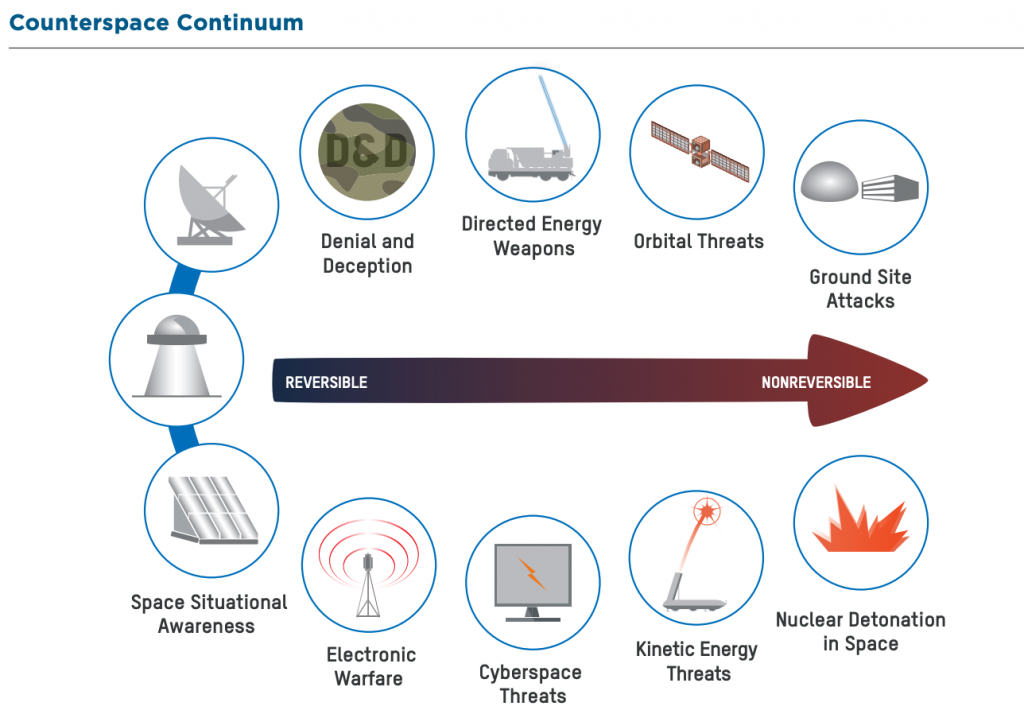Start your day with intelligence. Get The OODA Daily Pulse.
Start your day with intelligence. Get The OODA Daily Pulse.
OODA recently updated the analysis below on threats to space based assets (with a focus on what the C-Suite needs to know) because of tensions with Russia and continued testing of satellite destruction capabilities (the most recent reported on here, which caused significant increases in dangerous space debris). We recommend this be read in conjunction with our report on what the C-Suite needs to know about the cybersecurity threats due to the coming Russian invasion of Ukraine. Also see: Russia-Ukraine Crisis: Resources for the Crisis Management Team
The last decade has seen an incredible increase in the commercial use of space. Businesses and individual consumers now leverage space solutions that are so integrated into our systems that they seem invisible. Some of these services include:
Space has also been used by criminal elements and at times nations seeking to disrupt businesses. Key examples to date include the unauthorized use of space-based communications systems for command and control of malicious code (worms and botnets). But this is just the tip of the iceberg. There are more threats to business from space than most realize.
The Defense Intelligence Agency (DIA) provided a report titled “Challenges to Security in Space” which provides some key insights here. OODA analysts Michael Brooks, Matt Devost and Bob Gourley have extracted key elements of this report, and make recommendations for your business below.
Introduction
 The DIA report “Challenges to Security in Space” was released to “support a deeper public understanding of key space and counterspace issues and inform open dialogue and partner engagement on these challenges,” according to a DIA spokesperson. The report highlights the growing importance of space-based capabilities across public and private sectors, and warns of the new risks posed to the U.S. by these capabilities and technologies.
The DIA report “Challenges to Security in Space” was released to “support a deeper public understanding of key space and counterspace issues and inform open dialogue and partner engagement on these challenges,” according to a DIA spokesperson. The report highlights the growing importance of space-based capabilities across public and private sectors, and warns of the new risks posed to the U.S. by these capabilities and technologies.
“The advantage the U.S. holds in space—and its perceived dependence on it—will drive actors to improve their abilities to access and operate in and through space,” it states. “These improvements can pose a threat to space-based services across the military commercial and civil space sectors.” Russia and China are the leading named threats, with half of the report focused on covering the capabilities and threats posed by each country, but the report also underscores Iran and North Korea’s space-based offensive capabilities.
Key Space Concepts
The architecture of space-based technologies underpins many technologies Americans take for granted. Communication satellites, for example, support mobile phones, television streams, broadband internet, and data transfer services for individuals, commercial applications, civil government, and the U.S. military. Intelligence, Surveillance, and Reconnaissance satellites provide essential data collection services for a wide range of uses. Space-based missile warning sensors are also a key component of the U.S. missile defense infrastructure, while additional space-based systems allow everything from individual GPS data to massive military command-and-control functions.
Key Counterspace Concepts
With a country and world increasingly reliant on these space-based services for daily life, countries have worked to develop weapons to target them in the event of war. Cyberspace threats, directed energy weapons for disabling space-based equipment, and electronic warfare technologies using the electromagnetic spectrum to target space-based equipment are three leading threats to space-based critical infrastructure. Ground-based anti-satellite missiles and orbital delivery of anti-satellite weapons also extend the threats into more traditional, kinetic domains.
Key Identified Threats
The report does not hesitate to identify nation-state actors as the leading threats to American infrastructure in space. “Chinese and Russian military doctrines indicate that they view space as important to modern warfare and view counterspace capabilities as a means to reduce U.S. and allied military effectiveness,” begins its risk summary. “Both have developed robust and capable space services, including space-based intelligence, surveillance, and reconnaissance…Both states are developing jamming and cyberspace capabilities, directed energy weapons, on-orbit capabilities, and ground-based anti-satellite missiles that can achieve a range of reversible to nonreversible effects.
Iran and North Korea also pose a challenge to militaries using space-enabled services, as each has demonstrated jamming capabilities. Both countries also maintain independent space launch capabilities, which can serve as avenues for testing ballistic missile technologies.”
China
“To explore the vast cosmos, develop the space industry, and build China into a space power is a dream we pursue unremittingly,” reads China’s Space White paper from the end of 2016. Chinese efforts to “explore,” “develop,” and “build” lagged behind the U.S. and the USSR during the Cold War, but have made significant leaps in recent years. The country is currently second only to the US in the number of operational satellites and is working to close gaps in other areas. While China has supported non-weaponzization of space in UN forums and elsewhere, they have continued to pursue counterspace weapons capabilities and integrate them into its military.
China’s broader military strategy emphasizes the ability to win “informatized local wars” with a focus on “maritime military struggle.” This informatization is understood to mean that wars will be fought in the domains of space, cyber, and the electronic spectrum that allow modern command-and-control systems. The DIA has interpreted the “key components” of China’s space superiority military doctrine as “the ability to control the information sphere, and [deny] adversaries the same.”
To support this doctrine, the Chinese military has been reorganized to incorporate space command structures. The PLA continues to manage the country’s space program, and civilian space operators are connected to its command and information structures. These programs are spread out across China’s territory, but its space capabilities are also spreading to bases and partnerships beyond their borders. These capabilities are believed to include high levels of all currently known layers of counterspace concepts and weapons (e.i. weapons harnessing directed energy, electronic jamming, cyberspace techniques, orbital techniques, kinetic energy, and more).
The US intelligence Community Annual Threat Assessment described the Chinese space threat as:
For more see the OODA special report: China Threat Brief.
Russia
“Only with support from space will it be possible for the Armed Forces to reach maximum effectiveness,” declared Russia’s defense minister last year, providing a clear and concise example of how Russia views space and its place in modern warfare. To the DIA, “Russia views its space program as a longstanding example of its leadership on the international stage,” where its previous Cold War successes in that area are a point of national pride. For a “resurgent” Russia, its vast experience, knowledge, and infrastructure for space operations have made it a global leader in the domain after a period of regression caused by lost budgets. The result in 2019 is a space program that is “more robust but more narrowly focused and its budget more limited than China’s.”
This “more narrowly focused” program has not prevented Russia from prioritizing the development of powerful counterspace weapons. Simultaneously, the country is vocal about its concern over weaponization in space, particularly by the US, and supports the development of arms control agreements “to curb what it sees as U.S. weaponization of out space,” as the DIA report reads. Like its “more narrowly focused” program, its vocal warnings about space weaponization have similarly failed to slow its own development of counterspace capabilities, which extend to “space situational awareness,” “electronic warfare,” “cyberspace threats,” “orbital threats,” “directed energy weapons,” and “ground-based kinetic energy threats.” These are further supported by strong space capabilities in space launch capabilities, human spaceflight and exploration capabilities, and ISR/Navigation/Comms capabilities.
Concerning the infrastructure for these programs, its space and counterspace capabilities are mostly based across territorial Russia, with some leased sites in Kazakhstan. Russia is also contracted by the European Space Agency to conduct launches from French Guiana. These facilities are run by military and civilian space programs, the former of which is led by the Aerospace Forces, formed by a merger of the Air Force and Aerospace Defense Troops. The country’s civil space program is nearly entirely state-owned, spread across 75 different enterprises overseen by Roscosmos.
Russia continues to train its military space elements and field new antisatellite weapons to disrupt and degrade U.S. and allied space capabilities, and it is developing, testing, and fielding an array of nondestructive and destructive counterspace weapons—including jamming and cyberspace capabilities, directed energy weapons, on- orbit capabilities, and ground-based ASAT capabilities—to target U.S. and allied satellites.
For more see the OODA special report: Russia Threat Brief.
Other Nation’s of Interest
There are also threats from DPRK and Iran, but these are less sophisticated than those from Russia and China. For strategic background on these nations see:
The Counterspace Continuum
DIA succinctly captured the full spectrum of threats to space in a graphic in their report titled “The Counterspace Continuum.” This graphic is reproduced here:

What Comes Next?
Globally, the space industry will continue to expand as technological and cost barriers fall and international partnerships for joint production grow. State, non-state, and commercial actors increasingly will have access to information from space. The number of satellites and debris on orbit will grow concurrently, making tracking satellites, discriminating threats from non-threats, and predicting and preventing collisions a greater challenge.
As the number of spacefaring nations grows and as some actors integrate space and counterspace capabilities into military operations, these trends will pose a challenge to U.S. space dominance and present new risks for assets on orbit.
What The Business Decision-Maker Should Do About This?
The DIA report provides useful insights that are rarely discussed in open venues. This is a positive step in helping inform the business community. However, the report does not provide actionable recommendations for industry (this is not the charter of DIA). Businesses can and should take action now to reduce risk to operations from conflict in space.
Here are our recommendations for mitigating space threats to your business:
The Cyber Threat to NASA Artemis Program
Now more than ever, organizations need to apply rigorous thought to business risks and opportunities. In doing so it is useful to understand the concepts embodied in the terms Black Swan and Gray Rhino. See: Potential Future Opportunities, Risks and Mitigation Strategies in the Age of Continuous Crisis
Use OODA Loop to improve your decision making in any competitive endeavor. Explore OODA Loop
The greatest determinant of your success will be the quality of your decisions. We examine frameworks for understanding and reducing risk while enabling opportunities. Topics include Black Swans, Gray Rhinos, Foresight, Strategy, Stratigames, Business Intelligence and Intelligent Enterprises. Leadership in the modern age is also a key topic in this domain. Explore Decision Intelligence
We track the rapidly changing world of technology with a focus on what leaders need to know to improve decision-making. The future of tech is being created now and we provide insights that enable optimized action based on the future of tech. We provide deep insights into Artificial Intelligence, Machine Learning, Cloud Computing, Quantum Computing, Security Technology, Space Technology. Explore Disruptive/Exponential Tech
Security and resiliency topics include geopolitical and cyber risk, cyber conflict, cyber diplomacy, cybersecurity, nation state conflict, non-nation state conflict, global health, international crime, supply chain and terrorism. Explore Security and Resiliency
The OODA community includes a broad group of decision-makers, analysts, entrepreneurs, government leaders and tech creators. Interact with and learn from your peers via online monthly meetings, OODA Salons, the OODAcast, in-person conferences and an online forum. For the most sensitive discussions interact with executive leaders via a closed Wickr channel. The community also has access to a member only video library. Explore The OODA Community